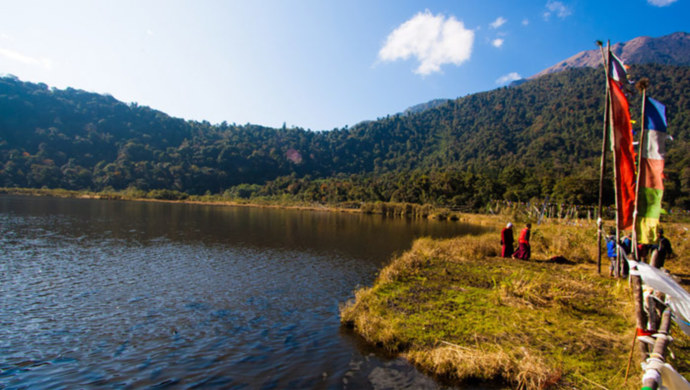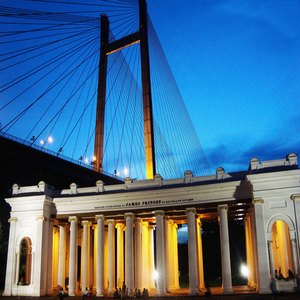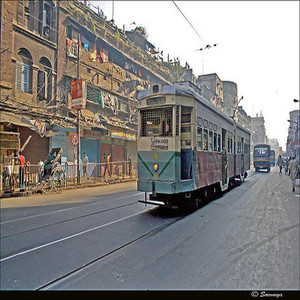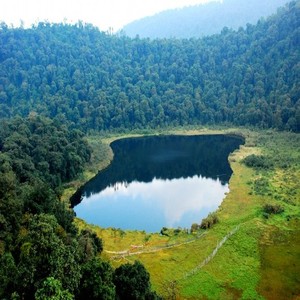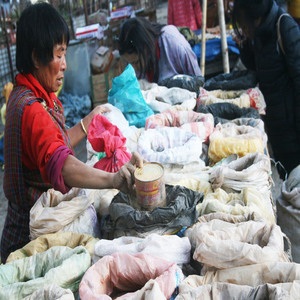Day 1. Arrival in Kolkata:
After the completion of immigration formalities at the Kolkata Airport, at exit door you will be received by your local representative. Afterwards you are driven to your hotel for Check-In. Check In would be on immediate occupancy basis. Rest of the day is at leisure. Post lunch you would be taken on a short city tour, covering the following:
- Victoria Memorial, a large marble palace built between 1906 to 1921 to commemorate Queen Victoria’s 25-year reign in India. It is filled with vast collection of remnants from the period of British Empire Rule in India. Adjacent to the structure, you can enjoy Maidan, one of the largest urban park in the world.
- Saint Paul’s Cathedral, acknowledged as the first Episcopal Church of the eastern world. It is an Anglican cathedral of the Church of North India. Besides, being a religious site, the cathedral is also an architectural marvel.
Post sight seeing, you are driven back to the hotel. Evening free for leisure.
Meals – Lunch and Dinner; Overnight at the Hotel in Kolkata
Day 2. Kolkata Sightseeing:
Today you would be driven in and around Kolkata covering key places of interest. After an early breakfast you would visit:
- Flower’s Market, also known as Mallick Ghat Flower Market, it is located in Mallick Ghat near the southeast end of Howrah Bridge. This venue is a photographer’s paradise as the flower market is fascinatingly colorful virtually 24 hours a day. Best time to visit Kolkata flower market is early in the morning when fresh flowers are brought in by workers laden on their heads.
- Howrah Bridge, the most prominent land mark of the City. It is one of the busiest bridge in the world and caters to more than 100000 vehicles daily.
- BBD Bag Heritage Zone (Dalhousie Square), Drive past St. James Church, Kolkata High Court, Town Hall, Governor House, Eden Garden Stadium, GPO, Writer’s Building.
- Indian Museum, the largest and oldest Museum India. It has huge collection of rare antiques, ornaments, fossils etc. The museum is replete with the most impressive collection of archaeological, geographical and botanical objects.
- Mother Teresa Home, a holy place of pilgrimage established by blessed Mother Teresa in 1950. Attached with the building is a a small museum named ‘Mother Teresa’s Life, Spirit and Message’ which displays Mother Teresa’s worn sandals, battered enamel dinner-bowl, sari, crucifix, rosary, a few handwritten letters and spiritual exhortations.
- Koley Market, a photographer's Paradise. It is the largest wholesale market of Calcutta, if not eastern India. Meat, fruit, vegetables, tea, grains, dried fish, fresh fish and spices converge here from across provinces of rural West Bengal, before scattering to smaller market aisles or local homes.
- Kali Temple (locally known as Kalighat), devoted to Goddess Kali. It is the most prominent and popular temples in Kolkata visited by scores of devotees every day. It is one of the 52 Shaktipeeths of the Hindus.
In between, the above sightseeing, you would taste some of the most authentic Bengali cuisines. On completion of the city tour, you would be driven back to your hotel. Rest of the day free for leisure.
Meals – Breakfast, Lunch and Dinner; Overnight at the Hotel in Kolkata.
Day 3. Kolkata – Bagdogra – Gangtok:
Driving Distance: 125 Km, Driving time: 5 Hr., Altitude of Gangtok 1,600 m
Post breakfast, you would be driven to the Airport for your onwards journey to the hills. On arrival at Bagdogra Airport, you would be greeted by your guide. After lunch you would proceed to Gangtok. On the way, you would get good vantage points from where you could appreciate the view of the Himalayas. Enroute at Rangpo Border you must obtain Restricted Area Permit (RAP) from Sikkim Tourism Officers on the basis of duration of valid Indian Visa. On arrival at Gangtok, Check-in to hotel. Rest of the day at leisure. You can walk around to:
- M. G. Marg (Mall Road), the most happening place of Gangtok. It is also country’s first litter and spit free zone and no vehicular traffic is allowed into the marg. The Mall is lined with shops on both sides of the road so shopping becomes an added pleasure.
Meals – Breakfast, Lunch and Dinner, Overnight at the hotel in Gangtok.
Day 4. Gangtok Sightseeing:
After breakfast, you start for a full day city tour covering
- Rumtek Monastery, situated about 45 minutes drive from Gangtok. It is the seat of the Kagyu order, one of the 4 major Tibetan Buddhist sects. The Centre houses some of the world’s most unique religious scriptures and religious rare objects.
- Namgyal Institute of Tibetology (NIT), one of the most prestigious research institute in the world. It is a treasure of vast collection of rare Lepta, Tibetan and Sanskrit manuscripts, statues and rare Thankas (colorful tapestries used in Buddhist liturgy).
- Do-Drul Chorten or Stupa built by the Venerable Trullshi Rimpoche, head of the Nyingma order of Tibetan Buddhism, in 1945. Inside the stupa, there are complete mandala set of Dorjee Phurba (Vajra Kilaya), a set of Kang Gyur relic (Holy Book), complete 'Zung' (mantras) and other religious objects.
- Directorate of Handloom and Handicrafts (Cottage Industry and Handicraft Centre) is the recent name given to the old Handloom and Handicrafts Centre of Sikkim. It is located at a distance of half kilometer from the main market of Gangtok. It was established in the year 1957 with the aim of promoting and keeping alive the State's traditional art & craft. Visiting hours: Monday to Saturday from 09:30 hrs to 12:30 hrs and 13:00 hrs to 16:00 hrs.
- Enchey Monastery, an important seat of the Nyingmapa order, the Enchey Monastery is built on the Site Blessed by Lama Druptok Karpo, a tantric master known for his power of flying. This 200 years old monastery has in its premises images of gods, goddesses and other religious objects.
After the completion of sightseeing, return back to the hotel for relaxation.
Meals – Breakfast, Lunch and Dinner, Overnight at the hotel in Gangtok.
Day 5. Gangtok – Pelling (Pemyangtse):
Driving Distance: 120 Km, Driving time: 5 Hr., Altitude of Pelling: 2,073 m
This morning after breakfast, transfer to Pelling (Pemyangtse). On the way, you can visit
- Temi Tea Garden, in Ravangla. It was established in 1969 by the Government of Sikkim and is located in South Sikkim. It is the only tea garden in Sikkim and considered one of the best tea gardens in India and in the world.
- Samdruptse, the world's largest statue (118 feet) of the Buddhist Padmasambhava, also known as Guru Rinpoche, the patron saint of Sikkim. It lies on the Samdruptse hill opposite Namchi. As per the legend Samdruptse hill is actually a dormant volcano. Myths say that the Buddhist monks have been going on top of the hill and offer prayers to the volcano to keep it calm.
Lunch would be provided at a local restaurant in Ravangla.
- Buddha Park also known as Tathagata Tsal features a 130-foot high statue of the Buddha as its centerpiece. The statue was consecrated on 25 March 2013 by the 14th Dalai Lama. The statue of the Buddha marks the occasion of the 2550th birth anniversary of Gautama Buddha.
Later continue your journey to Pelling. On arrival at Pelling, check-in to your hotel. On a clear sunny day, you can experience an unforgettable view of Mount Kanchendzonga range from this place. Rest of the evening free for leisure.
Meals – Breakfast, Lunch and Dinner, Overnight at the hotel in Pelling.
Day 6. Pelling Sightseeing:
After breakfast, start for half day sightseeing tour of Pelling which includes:
- Darap Village located about 6 kilometers from Pelling on the way to Yuksom. It is habited mainly by People from Limboo Community and small number of families from mixed communities. The land scape of the area is moderately sloped. It is coming up as a popular home stay destination.
- Rimbi Water Falls, located about 12kms away from Pelling. It falls on the way to Khecheopalri and Yuksam. The main attractions here are the river, water falls, oldest Hydel power station, Sewaro rock garden and the village.
- Khecheopalri Lake, which lies about 25kms from Pelling at a height of about 6000ft. It is very holy and wish fulfilling lake for both the Buddhist and the Hindus. The Lake is hidden under the rich forest cover. It is interesting to know that the birds do not permit even a single leaf to float on the lake surface.
- Khangchendzonga Waterfalls which lies about 28kms from Pelling and 18kms after Rimbi and 5kms before Yuksom. It is situated at a sharp curve on the road side. Because of the huge size of the falls, it has become one of the leading tourist spots in west Sikkim.
Post sightseeing, you return back to the hotel for lunch. After lunch, check out of the hotel and proceed to Darjeeling. On the way stop at
- Pemayangste Monastery, one of the oldest monasteries of the State. It was originally established by Lhatsun Chempo, one of the revered Lamas known to have performed the consecration ceremony of the first Chogyal (Monarch) of Sikkim. Being located on a hill top at an altitude of 6300 ft., it commands a magnificent panoramic view of the Himalayan ranges, its surrounding hills and the countryside.
Enroute at Nayabazar border you must submit Restricted Area Permit (RAP) to Sikkim Tourism Officers on the basis of duration of valid Indian Visa. On arrival at Darjeeling, check-in to your hotel. Rest of the evening free for leisure. You have an option strolling around the
- The Mall Road (Chowrasta), which originates and culminates at the Chowrasta. It is ideal for a leisurely walk around a setting that is perfect. A walk around The Mall is a must at any time of the day with the pleasant view of the mountains, valleys with rhododendron trees and old houses.
Meals – Breakfast, Lunch and Dinner, Overnight at the hotel in Darjeeling.
Day 7. Darjeeling Sightseeing:
Early Morning at 04:00 am drive to
- Tiger Hill, famous for its spectacular panoramic view of Mount Everest (8,848 m) and Mt. Kangchenjunga (8,586) together. Dawn is the best time to witness this marvel. The first rays of the sun shoot ahead and shed light on the twin peaks of Kangchenjunga, painting it pink and then bathing it in a beautiful orange color.
On your way back, visit
- Ghoom Monastery, the most famous Buddhist monastery around Darjeeling which belongs to Gelugpa, Yellow Sect. It was founded in the late 1800s by Lama Sherab G around Darjeeling Yatso. The most revered image in the monastery is a 5 meters/16 feet tall clay statue of the Maitreya Buddha.
After Breakfast, you would be taken for “Joy Ride” on the
- The Darjeeling Himalayan Railway (DHR), nicknamed the "Toy Train" – It is a narrow-gauge railway from Siliguri to Darjeeling in West Bengal run by Indian Railway. It was built between 1879 & 1881 and is about 88 kms long. It is still powered by steam engine. UNESCO has declared the DHR as a World Heritage Site. The landscape can only be described as spectacular and view of Himalayan peaks are breathtaking. The famous Joy Ride on Toy Train ride over DHR can be enjoyed from Darjeeling to Ghoom and back. The fare also includes free entry to DHR museum at Ghoom Station. It operates 4 times in a day for the tourist only. During the Joy Ride, you would also enjoy photo stop over at
- Batasia Loop, name given to a portion of the Toy Train tracks just below Ghoom, 5 km from Darjeeling. Batasia means Windy Place. It is an engineering marvel where the railway line negotiates a graceful circle and descends 305 meters / 1000 ft. almost imperceptibly.
Lunch would be served in a local Restaurant. Post lunch, you would be taken for city tour, covering:
- Japanese Temple & Peace Pagoda (Shanti Stupa), located in the Jalapahar hill, the Japanese Temple is built in traditional Japanese style where you can join the prayers and feel the spiritual peace amongst humming and chants. Close to it, is the Peace Pagoda where there are four large avatars of Lord Buddha. It was established by Nipponzan Myohoji, a Japanese Buddhist order.
- Himalayan Mountaineering Institute (HMI), premier mountaineering Institute in the country established in 1954 after the first successful ascent of Mount Everest by late Tenzing Norgay and Sir Edmund Hillary, under the personal initiative of Late Pt. Jawaharlal Nehru.
- Tibetan Refugee Self Help Centre, established on 1st October 1959 to rehabilitate displaced Tibetans Refugees who had followed His Holiness, Dalai Lama, to India in early 1959. This Centre produces excellent carpets, woolen goods, wood work, leather work etc. It is closed on Sundays.
Post sightseeing, you return back to the hotel. Evening free for leisure.
Please note – The itinerary for this day may be altered depending on the “Joy Ride” schedule.
Meals – Breakfast, Lunch and Dinner, Overnight at the hotel in Darjeeling.
Day 8. Darjeeling – Kalimpong:
Driving Distance: 57 Km, Driving time: 2.5 hrs., Altitude of Darjeeling: 1,250 m
Post breakfast, you would be transferred to Kalimpong. On arrival at Kalimpong, Check-in to hotel. After lunch at the hotel, you would visit
- Deolo Hill, situated at a height of 1,676m. It is the highest point of Kalimpong town. The view from the Hill is a fantastic one. One can see the entire Kalimpong Town, the magnificent Mt. Kanchenjunga, the surrounding villages and Relli valley on one side with the Teesta River on the other.
- Army Golf Course is an excellent place for photography. You can focus from all angles at the valleys around and get classy photos of the Durpin monastery. The army golf course has a nine-hole course and visitors can play a round of golf by paying a small fee.
- Durpin Dara Hills - It is the highest point in Kalimpong accessible by car, located 3 km from the town. A view of the Himalayan ranges and plains along with River Teesta from here is the ostensible reason why Kalimpong is a magnet for the visitors.
- Zang Dhok Palri Monastery - Consecrated by the Dalai Lama in 1976. The monastery holds in its reliquary 108 volumes of the Kangyur, as well as other holy books and scrolls that were moved out of Tibet after the Chinese invasion.
- Pine View Nursery - Kalimpong is famous for its nurseries which export exotic flowers. Amongst them one of the highlights is visit to Pine View Nursery, home to thousands of cactus plants belonging to more than a hundred of variety collected from North, South and Central America. The Nursery won many Indian as well as International accolades.
After the completion of sightseeing you are transferred back to your hotel and rest of the evening at leisure.
Meals – Breakfast, Lunch and Dinner, Overnight at the hotel in Kalimpong.
Day 9. Kalimpong – Phuentsholing:
Driving Distance: 180 Km, Driving time: 5-6 hrs.
After breakfast Check-out from hotel on time and get transferred to Phuentsholing for onward journey. We hope by now you must have made some good friends and also have taken photographs and beautiful memories of the Great Himalayas. The drive to Phuentsholing is very beautiful, serene and nice. During, the drive you would enjoy Lava, a small hamlet in the midst of Alpine forest. In Dooars you would be driving through lush tea gardens, dense forests and dancing rivers flowing from the mountains. The roads are generally good. You can stop at few places for taking photographs to the nature at its best. Lunch would be provided on the way in local restaurant. On arriving at Jaigaon, as we are leaving India, you would have to complete the immigration formalities at Jaigaon Check Post before entering Bhutan.
On arrival in Phuentsholing, you will be received by your Bhutanese guide with traditional “Tashi Khadar” at the Phuentsholing Gate. You should also spend time taking the photographs of the huge ornate gate that welcomes you to Bhutan. Your guide shall assist you with the Immigration Formalities and then check in to hotel. This is one the few occasions where you cross into a new country over foot. As soon as you enter Bhutan, you would notice how drastic the transition is. You leave the crowd and the congestion behind. You would notice how cleaner the roads are with little or no litter. The architects of the building, increases the feeling that you have entered into new country. Later you may choose to relax in the hotel. Alternatively, if the time permits, you may also have an option of exploring the Phuentsholing town or visiting:
- Zangtopelri Lhakhang, a small Buddhist temple situated in the heart of Phuentsholing town representing celestial abode of Guru Rinpoche. In the ground floor, there are the statues of eight manifestations of Guru Rinpoche and paintings on Buddha's life. The next floor contains eight Bodhisattvas and statues of Avalokiteshvara and Zhabdrung Ngawang Namgyal. The top floor consists of the main statue of Amitabha, is a celestial Buddha described in the scriptures of MahÄyÄna Buddhism
- Crocodile Centre, a collection of marsh mugger and gharial crocodiles. The center also breeds these crocodiles for release in natural reserve. The crocodiles are fed every other day at noon.
Meals – Breakfast, Lunch and Dinner; Overnight at the Hotel in Phuentsholing.
Day 10. Phuentsholing – Thimphu:
Driving Distance: 176 Km, Driving time: 5 – 6 hr., Altitude of Thimphu: 2,350 m
After breakfast, drive to Thimphu. A few kilometers ahead, visit the
- Kharbandi Goemba, a monastery was founded by the Royal Grand Mother, Ashi Phuntsho Choden in the year 1967. The Monastery lies at an altitude of 400 m. It contains paintings on the life of Buddha, statues of Shabdrung Ngawang Namgyal and Guru Rinpoche. A fascinating view of Phuentsholing town and surrounding plains can be seen from the Monastery garden.
Drive further to Thimphu. For the way, it is preferable that you carry your own snacks, fruits and water as villages you past, may not have what you want. On the way you shall see and experience how the plains become small foothills and then the big Himalayan Slopes. You would find yourself in sky heights above the clouds. You shall come across diverse flora, fauna, beautiful landscapes, villages and other elements of nature such as waterfalls. Stop at places for sightseeing, photography and lunch. You would drive past, one mountain range after the other, past some extremely well-laid out roads, past little villages and charming Bhutanese houses. On arrival in Thimphu, check in hotel. You may choose to rest for a while. A private traditional Cultural Show would be organized especially for you in the evening.
Meals – Breakfast, Lunch and Dinner; Overnight at the Hotel in Thimphu.
Day 11. Thimphu Sightseeing:
Today you would be driven in and around Thimphu covering key places of interest. After breakfast you would visit
- Kuensel Phodrang, the gigantic Buddha Dordenma Statue located atop a hill in Kuensel Phodrang Nature Park.
- National Memorial Chhorten, a Stupa built in 1974 to honor the third Druk Gyalpo, Jigme Dorji Wangchuck. Every morning till night old people and young people circumambulate the Chhorten. You may choose to light butter lamps and also circumambulate around the Chorten.
- Zorig Chusum, Premier institute of traditional arts and crafts in Thimphu established with an objective of preserving “thirteen arts and crafts of Bhutan”.
- Folk Heritage, traditional house giving an insight to the Bhutanese lifestyle, and artifacts from the rural households
Thereafter, you would be taken to a local restaurant for lunch. In the afternoon you would be taken to
- Sangaygang View Point, also known as BBS Tower offering panoramic view of Thimphu Town situated at an elevation of 2,685 m.
- Takin Preserve Centre, see Takin (National animal of Bhutan) It is a unique combination of Goat and an Antelope
- Tashichhodzong, or ‘the fortress of the glorious religion’. Initially erected in 1641 by Shabdrung Ngawang Namgyal, it was rebuilt in the 1960s during the reign of Bhutan’s third king in the traditional style, without plans or nails. It houses some ministries, His Majesty’s secretariat, and the central monk body and opens after 5 PM.
On the completion of sightseeing, you are driven back to your hotel. After relaxing for some time you shall be served with dinner.
Meals – Breakfast, Lunch and Dinner; Overnight at the Hotel in Thimphu.
Day 12. Thimphu – Punakha/Wangdue:
Driving Distance: 76 Km, Driving time: 2.5 – 3 hrs., Altitude of Punakha: 1310 m
After breakfast you are driven to Punakha/Wangdue, for your second leg of the tour. On the way, after roughly an hour’s drive, you would stop at
- Dochula Pass, lies at an elevation of 3,150 m and is a great place to view the higher Himalayas. The landmarks around the pass includes 108 Druk Wangyal Stupas built under the patronage of Queen Ashi Dorji Wangmo Wangchuk.
You would drive through curvy, mountainous road, patches of which are being repaired. Owing to road widening work, you may find too many stalls along the road side selling snacks and water. It is preferable you buy it at the start of the tour. The drive from Thimphu to Punakha over Dochula leads from cool heights of Thimphu to balmy, lush landscapes of Punakha. After arrival at Punakha, check in to the hotel. Post lunch, you would visit
- Punakha Dzong, built in 1637 by Shabdrung Ngawang Namgyal. For many years until the time of the second King, it served as the seat of the Government. It is still the winter residence of Je-Khenpo (The Chief Abbot of the Central Monastic Body of Bhutan)
- Chhimi Lhakhang, a famous Temple, which is also known as “The Temple of Fertility” built by Lama Drukpa Kuenley
Later you are driven back to the Hotel. Evening free for leisure activities.
Meals – Breakfast, Lunch and Dinner; Overnight at the Hotel in Punakha/Wangdue.
Day 13. Punakha – Paro:
Driving Distance: 135 km, Driving Time: 4-5 hrs., Altitude of Paro: 2280 m
After breakfast, you would check out of the hotel to proceed to Paro for the final leg of the tour. On the way stop at
- Royal Botanical Park, Lamperi, also known as the Rhododendron Garden. It is the first Botanical Garden of Bhutan. It is famous for 46 species of rhododendrons.
Till you reach Thimphu, you would drive through the same route which you took which driving to Punakha. Again owing to road widening work, you may find too many stalls along the road side selling snacks and water. It is preferable you buy it at the start of the tour. After arriving at Paro, you would be transferred to you Hotel for Check In. Post lunch, you would be taken around to visit
- Paro Rimpung Dzong, also known as Fortress of the heap of jewels, built during the time of Shabdrung Ngawang Namgyal in 1646
- Ta Dzong, an ancient watch tower overlooking Rimpung Dzong built in 1951 now converted into national museum.
Later you are driven back to the Hotel. Evening is free for leisure activities and shopping around the Paro Town.
Meals – Breakfast, Lunch and Dinner; Overnight at the Hotel in Paro.
Day 14. Paro Sightseeing & Hike to Taktsang:
After breakfast, start your day with a hike to
- Taktsang Monastery (Tiger's nest), the abode of gods and monks situated at an altitude of 3100m on the Upper Paro Valley, Bhutan. As per the legend, Guru Padmasambhana (Guru Rinpoche), the tantrum mystic who brought Buddhism to Bhutan, came in the form of Dorje Droloe riding a flying tigress to subdue the demon that was obstructing the spread of Buddhism in the Himalayas.
After the completion of the hike, you would be served picnic lunch among the woods. Post lunch, visit
- Kyichu Lhakhang, one of the oldest monasteries in Bhutan built in the 7th century by the Tibetan Emperor Songtsen Gampo.
Later in the day, you would then drive to village house to witness the traditional rural life in a Bhutanese village. Also you have an option of experiencing a Traditional Hot Stone bath in the village house. You can also choose to have your dinner in the house with the Family or also spend your overnight in the village house (needed to be confirmed at the time of confirmation of the Tour) or be driven back to your hotel.
Meals – Breakfast, Lunch and Dinner; Overnight at the Hotel in Paro.
Day 15. Departure:
Today we will bid farewell to this beautiful country and take an early flight back. We hope by now you must have made some good friends and also have taken photographs and beautiful memories of Bhutan. We certainly hope of serving you again on your next visit to this great country or the Last Shangri-La. Tashi Delek
